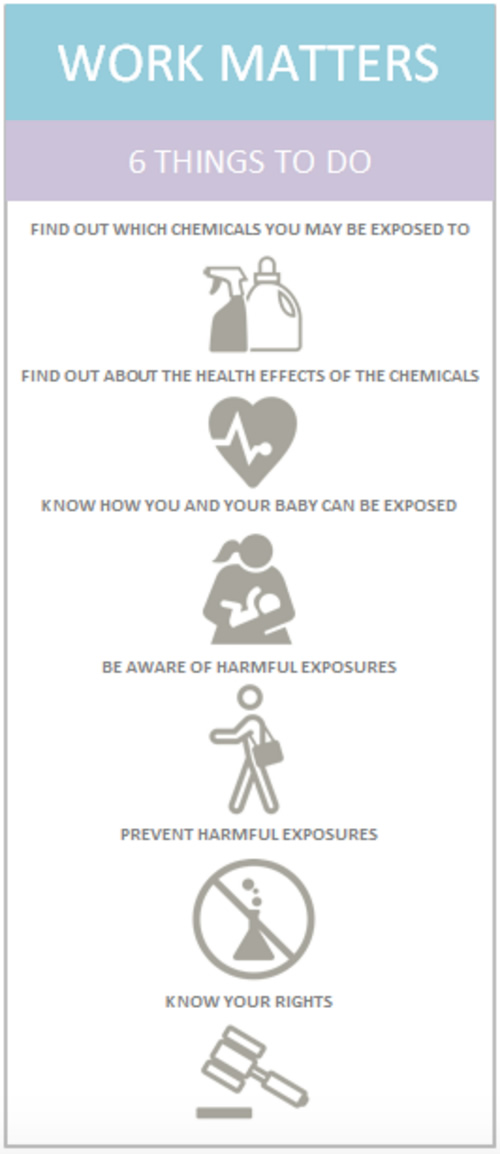Work Matters
Many workplaces contain toxic chemicals and other hazards that can affect your health. Some chemicals pose special concerns during pregnancy because they can cause miscarriage, affect growth or development, or cause birth defects.
Getting the information you need is the first step towards preventing harm. This website provides an easy to use, step by step guide to getting educated about workplace exposures and how you can protect yourself and your baby from harm. Click through the five steps below for more information and be sure to either view or download a printable version of the Work Matters brochure.
Six Steps of Work Matters

- Step 1: Find Out Which Chemicals You May Be Exposed To - Knowing the chemicals you may be exposed to at work is the first step towards being able to prevent harmful exposures. Your employer is required to provide you with this critical information, but it is also important that you know what to look for on your own.
- Step 2: Find Out About the Health Effects of the Chemicals You May Be Exposed To - Once you have identified a list of chemicals that you may be exposed to at work it is important to understand how each can affect your health. This will help you identify the specific chemicals that pose the greatest threat to your health and pregnancy.
- Step 3: Know How You and Your Baby Can Be Exposed to Chemicals - It is impossible to control the types of toxic chemicals used in your workplace, but you can educate yourself on the most common routes of exposure. This knowledge will help you better protect yourself from harmful exposures.
- Step 4: Be Aware of Harmful Exposures - The type of chemical you are exposed to, the amount, and how and when you are exposed are important factors in determining whether your exposure will be harmful.
- Step 5: Prevent Harmful Exposures - Completely avoiding exposure to toxic chemicals is the best way to protect your health. Most workplace chemicals have not been tested for reproductive and developmental health effects and therefore, you cannot rely on legal limits as an assurance of protection. However, if you cannot avoid chemical exposure all together, there are a variety of ways to keep exposure as low as possible.
- Step 6: Know Your Rights - As an employee, you have the right to a safe and healthy workplace. This basic right includes the right to information and training on harmful chemical exposures and protection against them. You also have the right to protection against pregnancy discrimination and to family and medical leave. Visit our Know Your Rights page to learn about your rights as a worker.
View or download a printable copy of the Work Matters brochure.
View or download a printable copy of the Sustancias Tóxicas en el Trabajo brochure.
Resources and Articles
DC-INFO delivers health information to consumer, health care professionals, and public health partners who call, mail, or email their inquiries about disease prevention and health promotion. Because occupational reproductive queries often describe unique or complex combinations of workplace exposure, they are routed to occupational reproductive epidemiologists at the National Institute for Occupational Safety and Health (NIOSH) who can provide individualized responses.
Specifically for healthcare providers, here is an article (Grajewski et al., 2016) that focuses on pregnant women and their work place and how to address questions and answers.
The California Department of Public Health's Work-Related Asthma Prevention Program (WRAPP) aims to identify industries, occupations, and exposures that put workers at risk for work-related asthma. Their website has guidance and resources for workers, health care professionals, employers, and schools/childcare to help prevent work-related asthma.
Learn about additional resources and check out recent articles and videos on the Work Matters Resources page.
